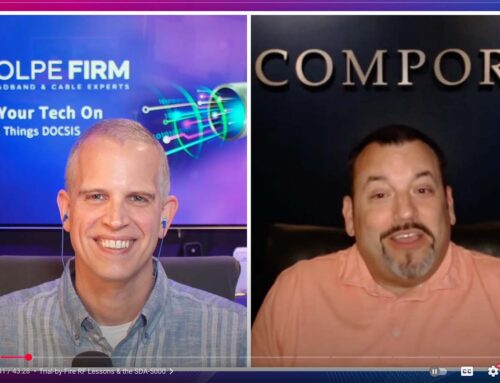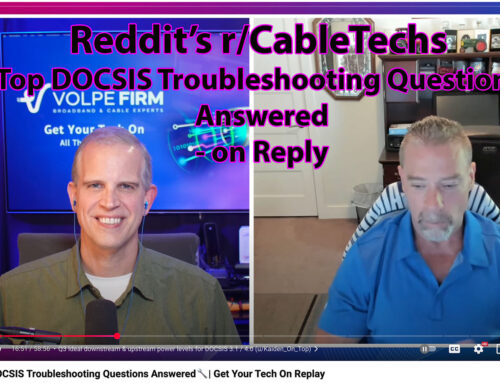Podcast: Play in new window | Download | Embed
Subscribe: Spotify | Email | RSS | More
Operator Perspective of Technology Advancements in Cable and other interesting facts
Episode 19
Hosted by Brady Volpe of the Volpe Firm and Nimble This
Guest John Downey, CMTS Technical Leader at Cisco Systems and special guest, Jeff Finkelstein Executive Director of Network Strategy at Cox Communication.
Today’s show we will cover a number of topics including the CableLabs’s Winter conference, NCTC’s Winter Educational conference, SCTE’s Chapter PNM training and more…
But first, let’s cover some items happening in the news:
CableLabs has announced “A newly unveiled project at CableLabs illustrates how DOCSIS 3.1 technology provides the basis for continued evolution of system capacities by supporting symmetric multi-Gigabit service over the cable network.” See link: http://www.cablelabs.com/full-duplex-docsis-3-1-technology-raising-the-ante-with-symmetric-gigabit-service/
So is how does work? Will it only work on passive HFC systems?
Okay, let’s start into questions from our listeners:
Questions from the Mail Bag:
You have to listen.
We do our best to bring our audience great technical content every month. You can watch us live on the air or catch our recorded episodes on YouTube. Or download our audio only version with your favorite podcatcher.
If you have enjoyed this episode, please do hit the subscribe button so that you never miss an episode.
Thank you so much for being here and we will see you next month.
Upcoming events can be seen under Broadband Events. Previous events can be seen under the blog.
- If you are watching this on youtube please hit the subscribe button!
- Let us know what you think and remember to share!
- You can find slides at the bottom of the page and some on slideshare.
- Find out about events or articles by following us on Twitter, LinkedIn or Facebook too.
Also available on iTunes, Google Podcasts, Spotify, vurbl see podcasts “get your tech on”.





Hi Brady. Don’t know if the investments is going to worth. I have seen already some HFC field equipment EuroD 3.1 (and installed them, Fiber Node) .Not yet CMTS and modems. For the moment they are working as D.3.0, but sending the upstream up to 5-200MHz I am a bit skeptic. There are too 6.4MHz channel on the US and I don’t know if the optic laser is going to handle such load without clipping. We are having 4 US per node on our 5-65Mhz network and the FP laser could not handle such load than we go for DBF laser on node that have their cost too. That laser is very important in case you need to offer certain capacities. Also the bounding 192MHz (32 channel for the D.3.1 and 24 for the EUD3.1 -8MHz) just give the possibility to share better the Downstream (Now we have 8DS carrier for modem, close to 400Mbps) and even the higher modulation scheme does not hugely improve the deliver capacity ( in 8Mhz Eu carrier channel you get 15-20mbps more) but in the other hand you need to have a network quality to allow all these high scheme. Sending HFC to compete on data environment beyond any improvement that is done is something wrong. Pon network as I said on some forums, are very easy network to be build and to be maintained.I called network for dummies where you do not need engineers to run like you do need on HFC network. This is not only technologies clash but also on human resource problem. HFC guys are getting older day by day and now days the young ones are more blogger than engineers. A Pon network is easy to handle and to operate. You just have to explain to the guys do not go -26 or -29dBm to the customer and how to splice in case of fiber cut. That all. Mean while to cable guys you have to tell, node, optic level, amplifier, RF signal level, SNR, Coax cable, reverse/fw path, grounding, powering, terminating etc. To me the answer is simple. HFC network must go dipper with FO as much as they can. This will give them the possibility to offer more capacity through frequency reuse so they just x2 or x3 the capacity with one or two couple of fiber in the same area by replacing the amplifier with node powering these node from the same coax that the substitute amplifier was powered. The HFC net is very robust network on delivering DVBC better that any other technology but for data is not the proper one compare to be compare to FTTH.
episode 19 did not show up in my apples ios podcast app
Hi Michael, Thanks for letting us know. It should work now.